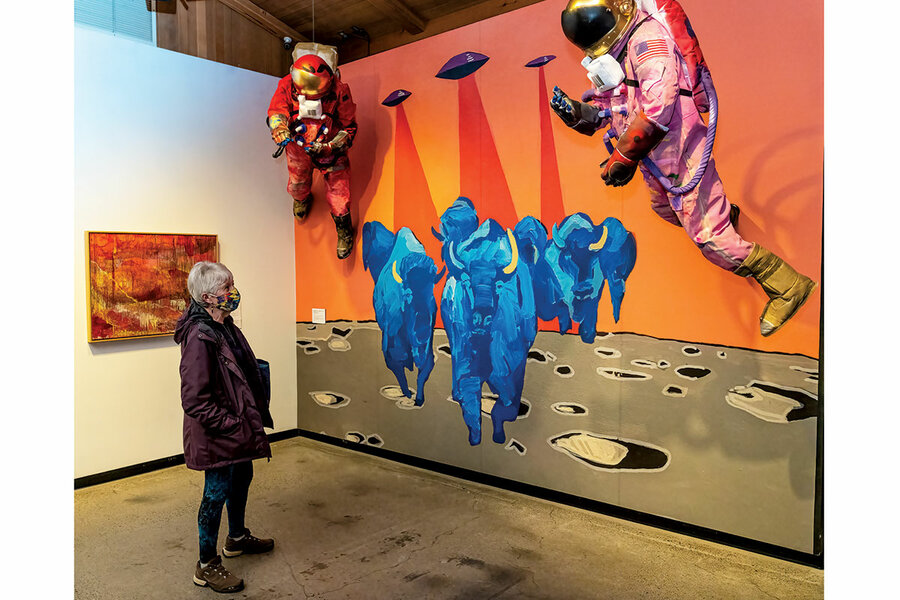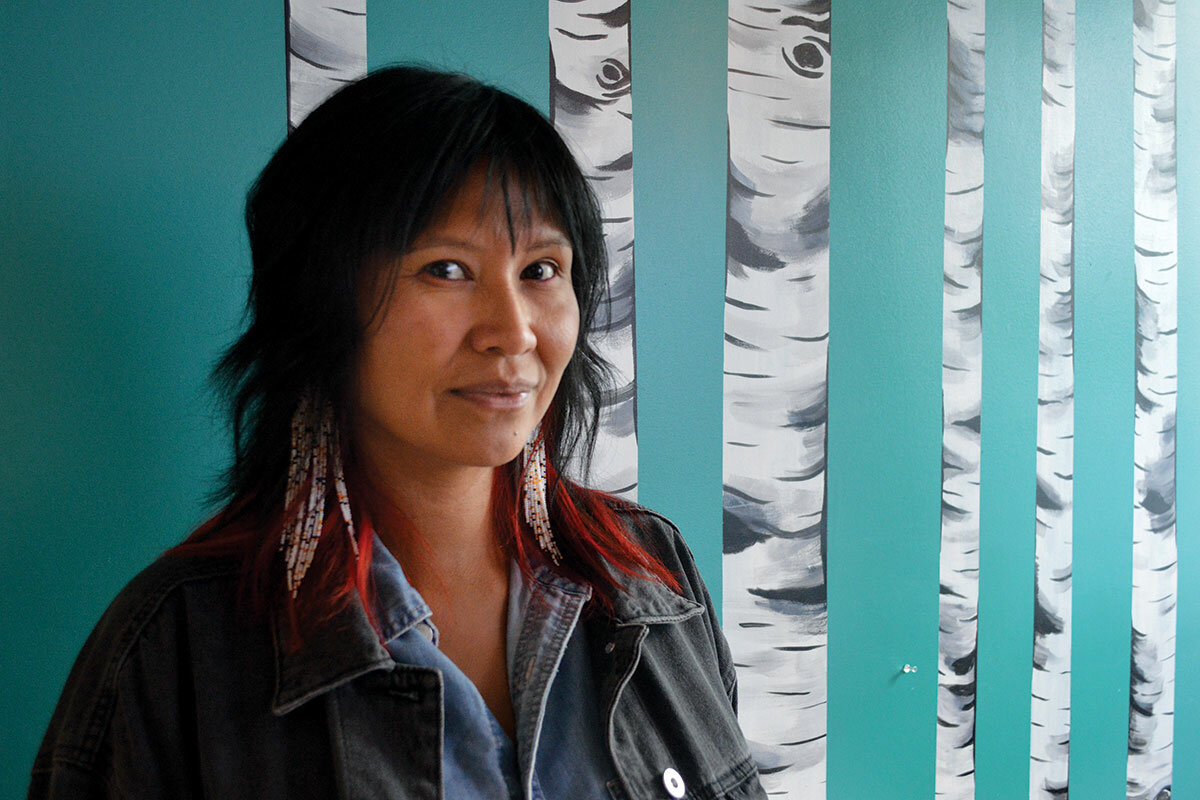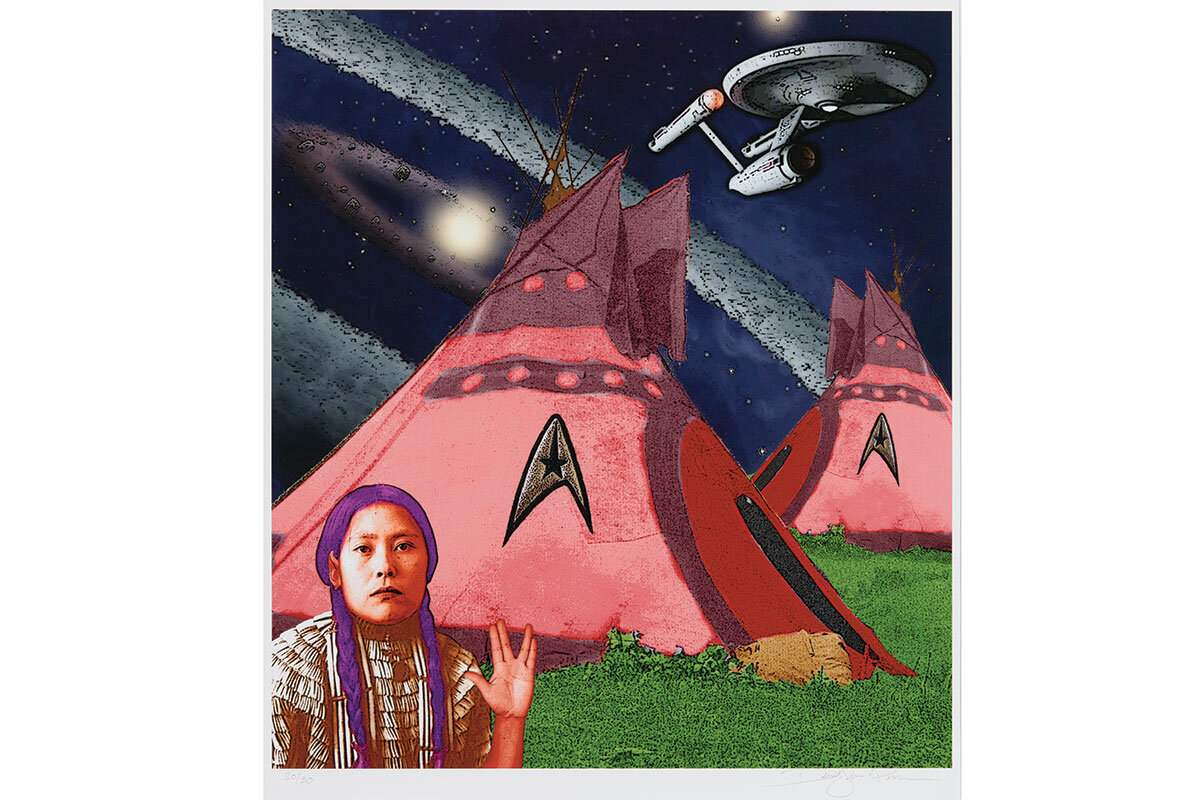How Indigenous artists explore crossroads of past and future
Loading...
| Yellowknife, Northwest Territories
There is nothing fast nor futuristic about moose hide tanning.
For Dene artist Melaw Nakehk’o, who first learned the practice from her late grandmother, it’s a multiday affair of scraping, drying, stretching, and smoking.
But when Ms. Nakehk’o featured that process in an exhibit in the fall in Yellowknife, Northwest Territories, her intent was not to look back – but far into the future.
Why We Wrote This
Indigenous futurism – which spans film, literature, the visual arts – is a way for centuries-old cultures to make the case that their path leads forward, not just back.
One of her hides became part of the “Moose Skin Dome,” in which 40 hide frames hung suspended from the ceiling, with images and sound from a tanning camp projected across its domed surface. The installation ran alongside an exhibit Ms. Nakehk’o curated called “Indigenous Futures: Rooted and Ascending” at the Prince of Wales Northern Heritage Centre here in the Canadian provincial capital. It showcased the work of Indigenous artists blending technology and traditional techniques as they explored Indigenous futurism with a central question: “If colonial oppression did not exist, what would the future look like?”
Indigenous futurism, which has been gaining attention in recent years across North America, is part of a social and cultural rights movement of self-determination among Indigenous creators and artists. In particular, it has reclaimed space in museums, libraries, and theaters that have so often been set on placing Indigenous culture in the past.
“When I started hide tanning, everybody said, ‘Oh, it’s a dying art; isn’t it sad?’ There’s this mourning about our cultural practices just fading away and a sense there’s nothing you can do about it,” says Ms. Nakehk’o, during lunch at Birchwood Coffee Kǫ̀ in Yellowknife in September as the exhibit was underway. “But there’s people that are actually learning this – from someone who is very much alive.”
Indigenous futurism means many things. It spans film and literature, visual arts, music, and comics. It incorporates science fiction or cosmology into its work but not always. Often it leans on traditional knowledge and storytelling using the most cutting-edge technologies available. What unifies the genre is work that projects Indigenous protagonists and culture in futuristic settings.
The term was first coined by Grace Dillon, an Indigenous studies professor at Portland State University who edited “Walking the Clouds: An Anthology of Indigenous Science Fiction” and who has said she was loosely inspired by the Afrofuturism movement. Indigenous futurism didn’t exist until a decade ago, but artists have been working in the genre since at least the early 1980s, says Manuela Well-Off-Man, an art historian and the chief curator at the IAIA Museum of Contemporary Native Arts (MoCNA) in Santa Fe, New Mexico. She points to work by Seneca artist Carson Waterman from that period.
But Indigenous futurism is certainly attracting more attention in recent years, she says. Her museum wrapped up an exhibit called “Indigenous Futurisms: Transcending Past/Present/Future” in January 2021.
The title nods at Indigenous knowledge and way of thinking that is not linear as it is in Western thought – a theme present throughout much of that exhibit. Many of the pieces grappled with questions of race and empowerment, she says. But artists are also pushing to decolonize fashion or cinema or science fiction, disciplines she says have left little space for Indigenous protagonists but also appropriated Indigenous culture without crediting it.
Mounting these exhibits also opens room for Indigenous creators who have been boxed-in historically. “We expect artists to look in the past, to build a beautiful traditional art form,” she says. “In other words, museums [and] the art world don’t allow Native artists to grow, and it’s very frustrating.”
The High Desert Museum in Bend, Oregon, has been trying to tackle a sense of “invisibility” faced by Indigenous communities by “indigenizing” its exhibits, says executive director Dana Whitelaw. Currently the museum is examining the idea of “intentional communities” – from ecological laboratories, such as Biosphere 2 in Arizona, to Oregon’s spiritual community Rajneeshpuram, in a 2022 offering called “Imagine a World.” A quarter of the exhibit is dedicated to “Indigenous Futurisms.” Dr. Whitelaw says the public has reacted with surprise – and curiosity.
“It is completely shifting the typical narrative of putting Indigenous people in the past,” she says. “And this is so clearly creating a narrative and a path for us to see Indigenous people in the future.”
She shows in a Zoom call from her office a painting she bought from one of the three participating artists, Frank Buffalo Hyde. It’s based on the original piece he created for the exhibit titled “Astra Sapiens NDN2K22,” depicting electric blue bison and astronauts on the moonscape.
In Canada, the exhibit in Yellowknife took visitors through a series of media, from a 3D animation called “Future Sweetgrass” by artist Casey Koyczan, in which the traditional braided plant was depicted in neon green pulsing on a screen, to beadwork outlining outer space called the “Milky Way Spiral Galaxy” by Margaret Nazon.
While traditional beadwork often depicts the natural world, here the bead artist interprets imagery from the Hubble Space Telescope. There are Mad Max-like illustrations by Cody Fennell, created for a fantasy, sci-fi, and horror film festival, and prints by Robyn McLeod from Yukon who uses archival photographs of traditional activities like moose hide tanning and fishing set on other planets.
The projections on the “Moose Skin Dome,” created in collaboration with Western Arctic Moving Pictures, feature educational work that Ms. Nakehk’o – an actor who appeared in the 2015 Leonardo DiCaprio film “The Revenant” – carries out for Dene Nahjo. That’s a nonprofit organization she helped found in the wake of the Idle No More protests in 2012, a trans-Canada Indigenous rights protest, in an effort to connect with the land and relearn Dene knowledge as a foundation for action.
In that sense the “Moose Skin Dome” – and the exhibits overall – are about acknowledging that the skills of her ancestors are just as important today as they have always been. “And it’s about taking that innovation in materials that we have and imagining how we want our community and our nations to be in the future,” she says. “It’s about who we are and how we represent ourselves in the world today and imagining where we want to be, where we want to go.”










